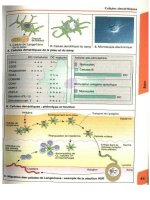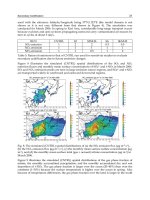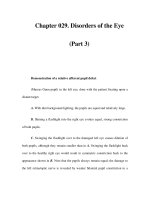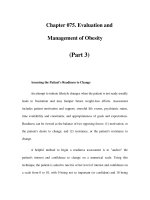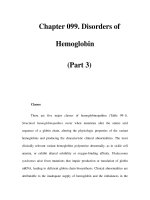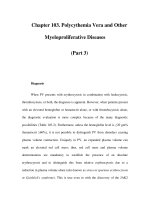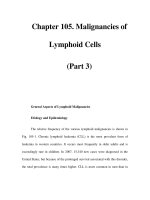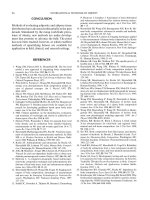Atlas of Neuromuscular Diseases - part 3 pptx
Bạn đang xem bản rút gọn của tài liệu. Xem và tải ngay bản đầy đủ của tài liệu tại đây (854.67 KB, 46 trang )
89
Cervical plexus and cervical spinal nerves
The ventral rami of the upper cervical nerves (C1–4) form the cervical plexus.
The plexus lies close to the upper four vertebrae. The dorsal rami of C1–4
innervate the paraspinal muscles and the skin at the back of neck.
Greater auricular
Greater occipital
Lesser occipital
Supraclavicular
Transversus colli
Transverse cutaneous nerve of the neck
Intertransversarii cervicis (C2–C7)
Rectus capitis anterior (C1–3)
Rectus capitis lateralis (C1)
Rectus capitis longus (C1–3)
M. longus colli (C2–6)
Major motor nerve: phrenic nerve
Fibers from C2–C4 also contribute to the innervation of the sternocleidomas-
toid and trapezius muscles
The ansa cervicalis connects with the hypoglossal nerve.
Other communicating branches exist with caudal cranial nerves and auto-
nomic fibers, cervical vertebrae and joints, and nerve roots/spinal nerves
(C1/C2 and C3–8).
Complete cervical plexus injury:
Sensory loss in the upper cervical dermatomes. Clinical or radiological evi-
dence of diaphragmatic paralysis.
High cervical radiculopathies:
Less common, affected by facet joint. C3/4 foramen most often involved.
C2/3: site for Herpes Zoster, with post-herpetic neuralgia possible.
C2 dorsal ramus spinal nerve (or greater occipital nerve) irritation is better
labeled “occipital neuropathy”.
Cervical plexopathies:
Rarely affected in traction injuries, and usually in conjunction with the upper
trunk of the brachial plexus. Findings include sensory loss in the upper cervical
Genetic testing NCV/EMG Laboratory Imaging Biopsy
++
Anatomy
Cutaneous nerves
Muscle branches
Clinical picture
90
dermatomes and radiologic evidence of diaphragmatic paralysis (phrenic
nerve).
Cervicogenic headache (controversial):
Although often cited, the evidence for this condition is unconvincing.
Lesser occipital nerve:
Damaged in the posterior triangle of the neck (e.g., lymph node biopsy). Causes
numbness behind the ear.
Neck tongue syndrome:
Damage to the C2 ventral ramus causes occipital numbness and paraesthesias
of the tongue when turning the head. Presumably there are connections be-
tween the trigeminal and hypoglossal nerve.
Nervus auricularis magnus (greater):
Traverses the sternocleidomatoid and the angle of the jaw. Injury causes
transient numbness and unpleasant paraesthesias in and around the ear.
Injury can occur during face-lift surgery, carotid endarterectomy, and parotid
gland surgery (injury to the terminal branches).
Occipital neuralgia/neuropathy:
Accidents, whiplash, fracture dislocation, subluxation in RA, spondylitic
changes, neurofibroma at C2.
Iatrogenic:
Operations, ENT procedures, lymph node biopsy
Trauma:
Traction injuries
History of operation. Imaging of spinal vertebral column. There are few reliable
NCV studies, except for the phrenic nerve.
Cervical radiculopathies.
Pain management, anti-inflammatory drugs, physical therapy.
Mumenthaler M, Schliack H, Stöhr M (1998) Läsionen des Plexus cervico-brachialis. In:
Mumenthaler M, Schliack H, Stöhr M (eds) Läsionen peripherer Nerven und radikuläre
Syndrome. Thieme, Stuttgart, pp 203–260
Stewart J (2000) Upper cervical spinal nerves, cervical plexus and nerves of the trunk. In:
Stewart J (ed) Focal peripheral neuropathies. Lippincott, Williams & Wilkins, Philadelphia,
pp 71–96
Symptoms
Pathogenesis
Diagnosis
Differential diagnosis
Therapy
References
91
Genetic testing NCV/EMG Laboratory Imaging Biopsy
(+) + + +
Brachial plexus
Fig. 1
. 1
Upper trunk,
2
Middle
trunk,
3
Lower trunk,
4
Lateral
cord,
5
Posterior cord,
6
Medial
cord,
7
Ulnar nerve,
8
Radial
nerve,
9
Median nerve,
10
Me-
dial brachial cutaneus nerve,
11
Medial antebrachial cutaneus
nerve,
12
Cervical plexus
92
Fig. 2
.
Various types of me-
chanical pressure exerted on
the brachial plexus: A Clavicu-
lar fracture with a pseudoar-
throtic joint. In some positions
electric sensations were elicited
due to pressure on the brachial
plexus. B A patient with arm
pain and brachial plexus lesion.
Note the mass over her right
shoulder. The biopsy showed
lymphoma. C MRI scan of a bra-
chial plexus of a 70 year old
woman, who was treated for
breast carcinoma 10 years earli-
er. Infiltration and tumor mass
in the lower brachial plexus
Fig. 3
.
Features of a long stand-
ing complete brachial plexus
lesion: A Atrophy of the left
shoulder and deltoid. B The left
hand is atrophic and less volu-
minous than the right hand. C
Left sided Horner’s syndrome.
D Trophic changes of the left
hand, glossy skin and nail and
nailbed changes
93
Fig. 4. Neurofibromatosis and
the brachial plexus. A MRI of
the nerve roots and brachial
plexus. Note tumorous enlarge-
ment of nerve roots and C bra-
chial plexus. B Note the palpa-
ble supraclavicular mass
Fig. 5. Radiation injury of the
brachial plexus: the upper pic-
ture shows the damaged skin
after radiation therapy. The right
hand is atrophic and has
trophic skin changes. The finger
movements were spontaneous
and due to continuous muscle
fiber activity after radiation of
the brachial plexus
94
The trunks of the brachial plexus are formed by the union of the ventral rami of
spinal nerves C5 to C8. The three trunks bifurcate into anterior and posterior
divisions. The ventral rami from C5 and C6 fuse to form the upper trunk, those
from C8 and T1 the lower trunk and the continuation of the ventral C7 fibers
form the middle trunk. The trunks branch and reassemble to form the anterior,
medial, and posterior cords (see Fig. 1).
The three major nerves of the brachial plexus:
a) The radial nerve is a continuation of the posterior cord and receives contri-
butions from C5–8.
b) The ulnar nerve’s fibers stem from C8 and T1 via the lower trunk and the
medial cord.
c) The median nerve has two components:
The lateral part, which is mainly sensory, is derived from C5/6 (via the upper
trunk and lateral cord) and some C7 fibers.
The medial part (all motor) is from C8 and T1 ventral rami, via the lower
trunk and the medial cord (median nerve muscles can be divided into two
segmental categories: some are innervated by C5–7, but most are by C8/T1).
Posterior rami of the brachial plexus:
Leave the spinal nerves and innervate paraspinal muscles.
Some nerves stem directly from the plexus:
Phrenic nerve (see also cervical plexus and mononeuropathies)
Dorsal scapular nerve (rhomboid muscles)
Long thoracic nerve (serratus anterior muscle)
Suprascapular nerve (supra and infraspinatus muscles)
Lateral cord:
Lateral pectoral nerve: upper pectoral
Musculocutaneous nerve: elbow flexors
Median nerve (C5/6)
Posterior cord:
Thoracodorsal nerve: latissimus dorsi
Axillary nerve: deltoid
Radial nerve
Medial cord:
Medial pectoral nerve: lower part of the pectoral muscle
Medial cutaneous nerve: supplying arm and forearm
Ulnar nerve
Median nerve (C8/T1)
Neck:
The interscalene triangle consists of the anterior scalene, medial scalene, and
first rib. The plexus emerges from behind the lower part of the sternocleidomas-
toid muscles, passes under the clavicle, and under the tendon of the pectoral
muscle to reach the axilla.
Anatomy
Composition of cords
Anatomically related
structures
95
T 1:
Lung apex and first part of the lower trunk. The lower trunk curves over the first
rib.
Subclavian vessels (artery, vein).
Various classifications of brachial plexus divisions:
a) Interscalene triangle
b) Clavicle
c) First rib
Supraclavicular
Infraclavicular
Supraclavicular:
Preganglionic and postganglionic
Supraclavicular:
Upper plexus: incomplete traction, obstetric palsy, brachial plexus neuropathy
Lower plexus: metastatic tumors (e.g., pancoast), poststernotomy, thoracic
outlet syndrome (TOS), surgery for TOS
Fig. 6. Traumatic lesion of the
left brachial plexus. Note the
deltoid muscle and muscles fix-
ing the scapula are intact. Atro-
phy of the lower arm and hand
muscles. Note the inward rota-
tion of the left hand while
standing
Lesions of the brachial
plexus
96
Infraclavicular:
Cords/branches: radiation, gunshot, humeral fracture, dislocation, orthopedic,
axillary angiography, axillary (anesthetic) plexus block, neurovascular trauma,
aneurysm
Panplexopathy:
Trauma, severe traction, postanesthetic paralysis, late metastastic disease, late
radiation-induced plexopathy
Different classification:
Upper brachial plexus lesion
Lower brachial plexus paralysis
Isolated C7 paralysis
Fascicular lesions (medial, lateral and dorsal)
Complete brachial plexus lesions
Plexus lesion with or without root avulsion
Symptoms depend on the site of the lesion (supraclavicular/infraclavicular), on
the cause (traumatic versus inflammatory or neoplastic) or association with
pain, sensory, or autonomic symptoms.
Lateral cord:
Weakness of elbow flexion, forearm pronation.
Sensory loss in the anterolateral forearm. Absent or diminished biceps brachii
reflex.
Medial cord:
Weakness of finger flexion, extension and abduction, and of ulnar wrist flexion.
Sensory loss: medial arm, forearm and hand.
Posterior cord:
Weakness of arm abduction, anterior elevation and extension.
Weakness with extension of the forearm, wrist and fingers.
The sensory loss varies over the deltoid to the base of the thumb.
Complete brachial plexus lesion (see Fig. 3 through 5):
Weakness of proximal and distal muscles, including levator scapulae and
serratus anterior.
Sensory: complete loss in affected areas, often with pain.
Root avulsion:
Clinically: Functional loss may affect the entire limb. Sweating is intact, with
severe burning, paralysis of serratus anterior, rhomboid and paraspinal mus-
cles. Associated with Horner’s syndrome (if appropriate root is damaged).
Tinel’s sign can be elicited in the supraclavicular region.
The neurologic examination may show signs of an associated myelopathy.
Radiographs may show fracture of transverse process, elevated hemidia-
phragm.
CT: spinal cord displacement, altered root sleeves, contrast media enhance-
ment.
MRI: traumatic meningoceles, root sleeves are not filled.
Symptoms
Signs
97
Electrophysiology:
NCV: Motor responses are unobtainable. Despite clinical sensory loss, sensory
NCVs are obtainable (preserved dorsal rootganglion).
F Waves are absent.
EMG: fibrillations in cervical and high thoracic paraspinal muscles.
Metabolic:
Diabetic ketoacidosis
Toxic:
Alcohol, heroin, high dose cytosine arabinoside
Vascular:
Hematoma, transcutaneous transaxillary angiograms, puncture of axillary ar-
tery, aneurysm.
Pseudoaneurysms: May result from trauma or injuries. Slow onset and develop-
ment.
Infectious:
Botulinus
CMV
EBV
Herpes zoster
HIV
Lyme disease
Parvovirus
Yersiniosis
Inflammatory-immune mediated:
Immunotherapy: interferons, IL-2 therapy
Immunization, serum sickness
– Neuralgic amyotrophy (Parsonage-Turner syndrome, acute brachial neuritis):
Clinically: sudden onset and pain located in the shoulder, persisting up to
2 weeks. Weakness appears often when pain is subsiding. The distribution is in
the proximal arm with involvement of the deltoid, serratus anterior, supra/in-
fraspinatus muscles. Other muscles that may be involved include those innervat-
ed by the anterior interosseus nerve, pronator teres muscle, muscles innervated
by the musculocutaneous nerve and diaphragm. Bilateral involvement occurs in
20%. Prominent atrophy develops, but sensory loss is minor. Antecedent illness in
30% of cases: upper respiratory infection, immunization, surgery, or childbirth.
Lab: CSF normal
EMG: Neurogenic lesion in affected muscles. Abnormal lateral antebrachial
cutaneous nerve in 50% of cases. Other nerves often unremarkable.
Other nerves that may be affected include the phrenic, spinal accessory, and
laryngeal nerve.
Prognosis: improvement begins after one or more months. Ninety percent
recovery is achieved in 2–4 years.
Treatment: pain control, physiotherapy.
Childhood variant: onset at 3 years, after respiratory infection, with full
recovery.
Pathogenesis
98
Differential diagnosis: Hereditary neuralgic amyotrophy, hereditary neuropathy
with liability to pressure palsies (HNPP)
– Multifocal motor neuropathy:
Rare type of polyneuropathy, immune mediated with two or more lesions and
with characteristic conduction block in motor NCV. Occasionally, the brachial
plexus is affected.
Clinically: progressive muscle weakness and wasting, sometimes with fascicu-
lations and cramps. Pain and sensory complaints are absent.
Electrophysiology: distantly intact NCVs. Motor NCV with supraclavicular
stimulation is difficult. Sensory NCVs are unimpaired.
MRI may show diffuse swelling of the plexus.
– Monoclonal gammopathy and CIDP:
MRI investigation of the brachial plexus in patients with these disorders have
shown involvement of the plexus.
Compressive:
– Rucksack paralysis:
Caused by carrying of backbags in recreational and military setting.
Clinically: Lesion of the upper and middle trunks, occasionally individual
nerves.
Pain is uncommon, parasthesias may occur.
Affected muscles include deltoid, supra/infraspinatus, serratus anterior, triceps,
biceps and wrist extensors.
Electrophysiology: conduction block, axonal loss in 25%.
Prognosis: recovery in 2–3 months.
Table 5. Lesions in neuralgic amyotrophy. A review by Cruz-Martinez, et al (2002) showed
the following distribution in 40 patients
Nerve Number of lesions Percentage
Suprascapular 25 30.9
Axillary 21 25.9
Musculocutaneous 11 13.6
Long thoracic 7 8.6
Radial 5 6.2
CN XI 4 4.9
CN VII 4 4.9
Dorsal interosseus 1 1.2
Anterior interosseus 1 1.2
Phrenic 1 1.2
Lateral antebrachial 1 1.2
cutaneous nerve
Total nerves 81
Modified from: Cruz-Martinez A, Barrio M, Arpa J (2002) Neuralgic amyotrophy: variable
expression in 40 patients. J Peripheral Nervous System 7: 198–204.
99
Genetic conditions:
Ehlers Danlos Syndrome
HNPP
Neuralgic amyotrophy
– Hereditary neuropathy with liability to pressure palsies (HNPP)
Chromosome 17p11.2-p12; dominant.
Clinically: recurrent painless brachial neuropathy. May be the only involvement.
Electrodiagnostic: Demyelination
Prognosis: Recovery is common
– Neuralgic amyotrophy (HNA1)
Chromosome 17q24-q25; dominant, distinct from HNPP.
Onset: first (occasionally congenital) to third decade.
Neurological: recurrent episodes occur over periods of years. Several years
may pass between episodes. Precipitating factors include surgery, stress, preg-
nancy, puerperium.
Clinically: weakness and pain.
The maximum weakness develops within several days, and symptoms may be
bilateral.
The long thoracic nerve can be involved and result in scapular winging. Cranial
nerves may also be associated: VII, X, VIII and associated Horner’s syndrome.
Sensory symptoms are less prominent.
Additional signs: hypotelorism, small face and palpebral fissure, syndactyly,
short stature.
Prognosis: complete recovery common after each attack.
– Chronic neuralgic amyotrophy (HNA2)
Autosomal dominant form.
A preceding event occurs in 25% of cases.
Onset is with painful muscles. May occur gradually (6 weeks to 2 years) leading
up to first attack
Persistent pain and weakness may occur between episodes.
Neoplastic involvement of the brachial plexus:
Extension of lymphoma
Metastatic breast cancer
Pancoast tumor (usually lung cancer)
Neoplastic plexus metastases have predominant involvement of C8–T1 roots or
of the lower trunk. Some patients have diffuse metastatic plexopathy or epidural
tumor extension accounting for the “upper trunk” deficits.
Tumorous brachial plexopathy is an early sign in lung cancer, and a late sign
in breast cancer. Extension of the tumor mass into the epidural space may occur
and cause additional spinal signs.
Radiation brachial plexopathy may show paresthesias of the first two digits as
the earliest symptom, and the majority of patients have weakness restricted to
muscles innervated by the C5–C6 roots.
The distinction between neoplastic involvement and radiation induced plex-
opathy is not always clear on clinical grounds. Many patients with radiation
brachial plexopathy have weakness involving mainly the muscles innervated
by the C8–T1 roots or lower trunk. Conversely, “diffuse” involvement of the
100
plexus in some studies was equally common among patients with metastases
and patients with radiation damage (see Fig. 5).
Contrary to prior classifications, acute plexopathies may occur during radia-
tion, as an early delayed plexopathy (4 months after radiotherapy), or late (“late
delayed plexopathy”) – see above.
Also an acute ischemic plexopathy due to thrombosis of the subclavian
artery has been described. Possibly concomitant chemotherapy may enhance
the radiation toxicity.
Primary tumors of the brachial plexus:
Rare: Neurofibromas associated with NF-1 or intraneural perineuroma (local-
ized hypertrophic neuropathy) (see Fig. 4).
Hemangiopericytoma
Neural sheath tumors
Neurofibromas about 30% NF 1, dumbbell tumors
Lipoma, ganglioneuroma, myeloblastoma, lymphangioma, dermoids
Malignant neurogenic sarcomas and fibrosarcoma
Schwannoma
Iatrogenic:
Radiotherapy: most common type. Usually painless, upper plexus preferred
(see Table 6).
Surgery: Neck dissection, carotid endarterectomy. Median sternotomy: e.g.,
coronary bypass surgery (2–7%). Unilateral lower trunk/medial cord damage
(C8), sometimes bilateral. Differential diagnosis: ulnar nerve compression at the
elbow.
Orthopedic and other surgeries: shoulder dislocations (axillary nerve), crutch
use, shoulder joint replacement, shoulder arthroscopy, radical mastectomy,
upper dorsal sympathectomy, humeral neck fractures.
General anesthesia: malpositioning, hyperabduction, stretch. Head rotation
and lateral flexion to opposite side. Lower shoulder and arm under the rib cage
with poor padding. Upper arm abducted and forearm pronated.
Upper trunk damage: head tilted downward, shoulder supports – less common.
Regional anesthesia: Postoperative paralysis is characterized by weakness,
paresthesias. Pain is not prominent. The recovery is usually good (after 3–4
weeks).
Injection paralysis: injection, plexus anesthesia, punctures of the axillary,
subclavian artery and jugular vein.
Traumatic:
Can be divided into closed and open plexus lesions.
The brachial plexus is vulnerable to injury, due to its superficial location and
the mobility of the adjacent structures (the shoulder girdle and neck).
A frequent cause of brachial plexus lesions are motorcycle accidents, which
may cause traction injuries or compress the plexus. Additionally, bone frag-
ments and hematoma can be sources of damage.
In traumatic brachial plexus lesions the additional hazard of root avulsion (in
addition to traction injuries) must be considered. The lower roots are often
101
affected, but the plexus lesion can also be confined to the upper plexus or the
whole plexus.
Birth injuries are tractional lesions and may affect upper portion (Erbs type)
or lower portion (Klumpkes type).
Open plexus lesions are caused by penetration e.g. gunshot, knife, or glass
wounds.
Pain is a frequently associated feature of brachial plexus trauma and is worst
with root avulsion, where it may be the source of constant pain.
Phrenic nerve conduction studies should be performed if a C4 root lesion is
suspected.
Neonatal brachial plexopathy: Occurs in less than 1% of cases in industrialized
countries.
Most commonly affects the upper plexus: C5/6, sometimes with C7.
Less frequent: C8/T1–lower plexus. Rarely affects the whole plexus.
The diaphragm can be involved in 5% of cases, and bilateral lesions occur in
10–20%.
Risks: high birth weight, prolonged labor, shoulder dystocia, difficult forceps
delivery.
Associated features: fractures of humerus or clavicle.
Half of the patients show complete or partial improvement within 6 months.
Surgery remains controversial.
Aberrant regeneration can occur in any traumatic plexus injury, leading to
innervation of other muscle groups either with or without motor function.
Others: “Burner” syndrome
Sudden forceful depression of the shoulder, occurs in US football. Transient
sudden dysesthesia occurs in the whole limb, but may remain longer in upper
trunk distribution.
Table 6. Brachial plexopathy: metastasis versus radiation therapy (RT)
Metastatic Post-radiation
Onset: Pain in shoulder and hand (C8/T1) Onset: Paresthesia, median nerve inner-
Palpable supraclavicular mass vated hand. Slowly progressive, with or
Less than three months after RT without pain
Lower supraclavicular lesion Infraclavicular lesion
Metastases elsewhere Duration: 2–4 years
Onset: 4–41 years
Horner’s syndrome RT: 44–50 Gy
“Pancoast” symptomatology
Imaging: mass
Electrodiagnosis: Electrodiagnosis: small sensory NCVs,
Denervation Conduction block across clavicle
Myokymia
Treatment Supportive
Reradiation?
Chemotherapy
Pain therapy
102
Proximal Lower Motor Neuron syndrome
Age: 45 to 76 years, predominantly male.
Clinical: upper extremities, asymmetric, with weakness of the lower motor
neuron. Asymmetric distribution with shoulder and elbow focus. Bulbar mus-
cles can be involved. Fasciculations occur. Reflexes reduced in arms, preserved
in legs.
Progresses to affect the legs and ventilation.
Differential diagnosis from ALS: slower development (2–6 years).
Laboratory:
Associated with anti-asialo-GM1 antibodies (10% to 20%)
Serum CK: Mildly elevated
Electrodiagnostic: EMG with denervation and reinnervation.
NCV: Normal
Differential diagnosis: Primary muscular atrophy (PMA), ALS, primary lateral
sclerosis.
Upon palpation: mass.
Laboratory, genetic analysis
Imaging: plain bone X ray, CT, MRI, adjacent structures: lung, ribs
Electrophysiology: NCV, EMG, more difficult to establish conduction block
over the brachial plexus
Sympathetic function: sweat tests
Diagnosis
Table 7. NCV studies
Sensory
Brachial Plexus
Trunk Cord Peripheral nerve
Upper Lateral Lateral antebrachial cutaneous nerve
Upper Lateral Median to first and second digit
Upper Posterior Radial to base of the thumb
Middle Posterior Posterior antebrachial cutaneous nerve
Middle Lateral Median to second digit
Middle Lateral Median to third digit
Lower Medial Ulnar to fifth digit
Lower Medial Dorsal ulnar cutaneous
Lower Medial Medial antebrachial cutaneous nerve
Motor
Upper Lateral Musculocutaneous nerve
Upper Posterior Axillary nerve
Upper Suprascapular nerve
Middle Posterior Radial nerve
Lower Medial Ulnar nerve
Other studies: F waves, spinal nerve root stimulation (electrical or magnetic), needle EMG
of distal and paraspinal muscles.
103
Brachialgias
Cervical radiculopathies
Cervical radiculopathies with root avulsion
Effort thrombosis
Myopathies
Proximal mononeuropathies: Axillary, suprascapular, long thoracic, musculo-
cutaneous
Shoulder injury:
Fracture and dislocation (axillary, suprascapular nerve)
Rotator cuff injury
Shoulder joint contractures
Fractures of the clavicle
Subclavian pseudoaneurysm
Orthopedic and rheumatologic conditions:
Periarthropathia humeroscapularis
“Frozen shoulder”
Due to the variety of brachial plexus lesions no general statement can be given.
Conservative therapy is aimed at pain management and inclusion of physio-
therapy to avoid contractures and ankylosis. If no improvement can be expect-
ed, muscle transfer to facilitate function can be considered.
The traumatic brachial plexus lesion is often a matter of controversy. Gener-
ally speaking a period of four months is considered appropriate to wait for the
recovery of neurapraxia. Then the brachial plexus is explored. Suturing and
grafting may lead to innervation of proximal muscles, but rarely reaches distal
muscles.
New developments show that avulsed roots can be reimplanted.
The prognosis is highly dependent on the cause.
Chaudry V (1998) Multifocal motor neuropathy. Sem Neurol 18: 73–81
Chen ZY, Xu JG, Shen LY, et al (2001) Phrenic nerve conduction study in patients with
traumatic brachial plexus palsy. Muscle Nerve 24: 1388–1390
Eisen AA (1993) The electrodiagnosis of plexopathies. In: Brown WF, Bolton CF (eds)
Clinical electromyography, 2nd edn. Butterworth Heinemann, Boston London Oxford, pp
211–225
Kori SH, Foley KM, Posner JB (1981) Brachial plexus lesions in patients with cancer. 100
cases.
Neurology 31: 45–50
Millesi H (1998) Trauma involving the brachial plexus. In: Omer GE, Spinner M, Van Beek
AL (eds) Management of peripheral nerve disorders. Saunders, Philadelphia, pp 433–458
Murray B, Wilbourn A (2002) Brachial plexus.
Arch Neurol 59: 1186–1188
Van Dijk JG, Pondaag W, Malessy MJA (2001) Obstetric lesions of the brachial plexus.
Muscle Nerve 24: 1451–1462
Wilbourn AJ (1992) Brachial plexus disorders. In: Dyck PJ, Thomas PK, Griffin JP, et al (eds)
Peripheral neuropathy. Saunders, Philadelphia, pp 911–950
Differential diagnosis
Therapy
Prognosis
References
104
True neurogenic TOS
Arterial TOS
Venous TOS
Nonspecific (disputed) neurologic TOS
Combinations
Droopy shoulder (see below)
Involvement of the lower trunk of the brachial plexus; young and middle aged
females, often unilateral.
Symptoms:
Paresthesias in the ulnar border of the forearm, palm, and fifth digit. Pain is
unusual, but aching of the arm may occur.
Signs:
Insidious wasting and weakness of the hand, with slow onset. Thenar muscles
(abductor pollicis brevis) are more involved than other muscles. Only mild
weakness of ulnar hand muscles. Sensory abnormalities are in lower brachial
plexus trunk distribution (ulnar nerve, medial cutaneous nerve of the forearm
and arm). Contrary to ulnar sensory loss, the fourth finger is usually not split.
Only in severe cases are intrinsic hand muscles wasted. Weakness may also
involve muscles of the flexor compartment of forearm.
Causes:
Compression by the anterior scalene muscle
Elongated transverse process (C7)
Fibrous band that extends from this “rib” to reach the upper surface of the first
thoracic rib
Musculotendineous abnormalities
Rudimentary cervical rib
Median and ulnar neuropathies: thenar wasting may be confused with carpal
tunnel syndrome (CTS)
Lower trunk or medial cord lesions
C8 and T1 radiculopathies
Syringomyelia
Plain radiographs
CT and MRI do not detect fibrous bands, but are good to exclude other causes
Electrophysiology: to exclude CTS
Characteristics: low or absent sensory NCV of ulnar and medial cutaneous
nerves.
EMG abnormalities of muscles lower trunk
Paraverterbrals are normal.
1. Conservative treatment: posture correction, stretching may relieve prob-
lems.
Thoracic outlet syndromes (TOS)
Several entities have
been described
True neurogenic TOS
Differential diagnosis
Investigations
Treatment
105
2. Orthosis to elevate shoulder
3. Surgery: resection of the first rib
Due to cervical rib and vascular involvement (subclavian artery compression
with poststenotic compression, or subclavian artery aneurysm).
Clinically may present with weakness and pain: resulting in unilateral hand and
finger ischemia and pain.
Minor vascular
involvement results in reduced arterial pulse during hyper-
abduction of the arm.
Occurs in young athletes and swimmers, from throwing, occlusion, stenosis,
aneurysm, or pseudoaneurysm. Humeral head may compress axillary artery.
With (or without) cervical rib.
No rib changes. Symptoms, but no objective changes of TOS.
Symptoms are variable: pain and paresthesias in the lower trunk distribution,
supraclavicular tenderness.
Stable and non-progressive.
Treatment: disputed, potentially the removal of the anterior scalene muscle.
Females with low set shoulders and long necks.
Symptoms: pain and paresthesias in upper neck, shoulder, head, sometimes
bilateral.
Reduced by passive shoulder elevation, increased by downward arm traction.
Electrodiagnosis: normal.
Bonney G (1965) The scalenus medius band: a contribution to the study of the thoracic
outlet syndrome. J Bone Joint Surg Br 47: 268–272
Katirji B, Hardy RW Jr (1995) Classic neurogenic thoracic outlet syndrome in a competitive
swimmer: a true scalenus anticus syndrome. Muscle Nerve 18: 229–233
Roos DB, Hachinski V (1990) The thoracic outlet syndrome is underrated/overdiagnosed.
Arch Neurol 47: 327–330
Swift DR, Nichols FT (1984) The droopy shoulder syndrome. Neurology 34: 212–215
Thoracic outlet
syndromes: Arterial
Disputed neurogenic
TOS
Droopy shoulder
syndrome
References
106
Lumbosacral plexus
Genetic testing NCV/EMG Laboratory Imaging Biopsy
+ + + DM (femoral)
Fig. 7
. 1
Branch to lumbar plex-
us,
2
Greater sciatic nerve,
3
Pudendal nerve
107
Fig. 8
. 1
Subcostal nerve,
2
Ilio-
hypogastric nerve,
3
Ilioin-
guinal nerve,
4
Genitofemoral
nerve,
5
Lateral cutaneous fem-
oris nerve,
6
Femoral nerve,
7
Obturator nerve
108
Fig. 9
. 1
Lumbar plexus,
2
Sac-
ral plexus
109
Three nerve plexus are commonly termed the “lumbosacral” plexus: lumbar,
sacral and coccygeal plexus (see Fig. 7 through 10).
Formed by the ventral rami of the first to fourth lumbar spinal nerves. Rami pass
downward and laterally from the vertebral column within the psoas muscle,
where dorsal and ventral branches are formed.
The dorsal branches of L2–4 rami give rise to the femoral nerve, which
emerges from the lateral border of the psoas muscle. The femoral nerve passes
through the iliacus compartment and the inguinal ligament.
The obturator nerve arises from the ventral branches of L2–4 and emerges
from the medial border of the psoas, within the pelvis.
The lumbar plexus also gives rise to the lateral cutaneous nerve of the thigh,
the iliohypogastric, ilioinguinal, and genitofemoral nerves, and motor branches
for the psoas and iliacus muscles.
Communication with the sacral plexus occurs via the lumbosacral trunk (fibers
of L4 and all L5 rami).
The trunk passes over the ala of the sacrum adjacent to the sacroiliac joint.
The sacral plexus is formed by the union of the lumbosacral trunk and the
ventral rami of S1–S4. The plexus lies on the posterior and posterolateral walls
of the pelvis, with its components converging toward the sciatic notch.
Sacral ventral rami divide into ventral and dorsal branches.
The lateral trunk arises from the union of the dorsal branches of the lum-
bosacral trunk (L4, 5), and the dorsal branches of the S1 and S2 spinal nerves.
The lateral trunk forms the peroneal nerve.
Fig. 10. Topical relations of
lumbar (
1
) and sacral (
2
) plexus
Anatomy
Lumbar
Sacral
110
The medial trunk of the sciatic nerve forms the tibial nerve, and is derived
from the ventral branches of the same ventral rami (L4–S2).
Other nerves originating in the plexus include the superior and inferior
gluteal nerves, the pudendal nerve, the posterior cutaneous nerve of the thigh
and several small nerves for the pelvis and hip.
Autonomic fibers are found within lumbar and sacral nerves.
Lumbar plexus injury can be mistaken for L2–L4 radiculopathies, or for femoral
mononeuropathies. Pain radiates into the thigh, with sensory loss in the ventral
thigh, and weakness of hip flexion and knee extension.
In sacral plexus injury sensation is disturbed in the gluteal region and
somewhat in the external genitalia. All lower limb muscles display weakness,
except those innervated by the femoral and obturator nerves.
Motor loss in some pelvic muscles, gluteus muscles, tensor fasciae latae,
hamstrings, and all muscles of the leg and foot can be caused by sacral
plexopathies with L5/S1 radiculopathies, or proximal sciatic neuropathies.
Lumbar plexus lesions may have pain radiating into the hip and thigh. The
motor deficit causes either loss of hip flexion, knee extension, or both. Adduc-
tors can be clinically spared, but usually show spontaneous activity in EMG.
Sensory loss is concentrated at the ventral thigh, but the saphenous nerve can
be involved. In acute lesions, patients have the hip and knee flexed.
The sacral plexus pain resembles sciatic nerve injury. Depending on the
lesion of the sacral plexus, motor symptoms are concentrated in L5, S1,
resulting in weakness of the sciatic nerve muscles. Proximal muscles that
exhibit weakness include the gluteus maximus muscle, but the gluteus medius
muscle is usually spared. Sensory symptoms may also involve proximal areas,
such as the distributions for the pudendal nerve and the posterior cutaneous
nerve of the thigh. Sphincter involvement can occur.
Metabolic:
Diabetic amyotrophy (“Bruns Garland syndrome”):
This entity has several names, including diabetic femoral neuropathy, although
usually more than the femoral nerve is affected.
Diabetic amyotrophy is usually a unilateral (but can be bilateral) proximal
plexopathy affecting the hip flexors, femoral nerve, and some adjacent struc-
tures. Vasculopathies, metabolic causes, or vasculitic changes have been de-
scribed.
A paper by Dyck (1999) summarizes the characteristic features: it typically
strikes elderly diabetic individuals between 36 and 76 years (median 65 years).
The duration of diabetes has a median of 4.1 years (range 0–36 years), HbA1c
has a median value of 7.5 (range 5–12). The CSF protein can be moderately
elevated and a mild pleocytosis may occur. All except one patient of this series
had type II diabetes.
A clinical feature is severe weight loss before the neurologic disease.
Pain is the dominant symptom, radiating into the hip or anterior thigh, and
weakness and atrophy occur. Hip flexors, gluteal muscles, and quadriceps
showed weakness, and adductors can be involved, demonstrating clearly that
Symptoms
Signs
Pathogenesis
111
this is not an isolated femoral neuropathy. The pain resolves, and quadriceps
atrophy occurs. After stabilization slow recovery can be expected.
Biopsies from the sural and peroneal superficial nerve display vasculitic
changes.
Therapy is confined to adequate pain control, as no specific treatment is
available.
Toxic:
Heroin
Vascular:
Ischemic plexopathy
Hemorrhage (thrombopenia, anticoagulation therapy) can lead to hematoma
in the psoas muscle, which induces weakness in the obturator and femoral
nerve territories. The femoral nerve can also be directly compressed. Knee jerk
is lost (see Fig. 12).
Arterial injections in the buttock may cause ischemic sciatic nerve and
plexus lesions. The onset varies from minutes to hours. Ipsilateral pelvic
muscles or blood vessels can be involved.
Injection of cis-platinum or fluoracil into the internal iliac artery may result in
plexopathy.
Abdominal aortic aneurysm may result in claudication.
Rarely, ischemic lumbosacral plexopathy with uni- or bilateral signs occurs.
Signs and symptoms can be expected after exercise, in particular walking uphill
or riding a bicycle. At rest patients can be symptom free, and have no signs.
The pain occurs in the gluteal region after exercise, and sensory loss or
disturbance is distally accentuated and not dermatomal. Weakness is proximal.
Electrodiagnostic tests are often normal. The causes are bilateral stenoses of
the iliac arteries or distal abdominal aorta, common or internal iliac arteries.
Treatment: Percutaneous transluminal angioplasty and application of stents.
Hemorrhagic compartment syndromes:
May be caused by anticoagulants or bleeding disorders.
Most frequently the femoral nerve is affected. The proximal iliacus muscle may
also be affected by hemorrhage.
Psoas bleeding may cause lumbar plexopathy.
Treatment is not clear: operative versus non operative treatment.
Infectious:
Abscess, Lyme disease, immunizations, EBV, HIV, CMV
Bilateral lumbar and sacral plexopathy can occur in HIV.
Inflammatory-immune mediated:
Injury caused by immune vasculopathy is characterized by advanced age,
asymmetric proximal weakness, and variable sensory loss. The course is pro-
gressive over weeks and months, sometimes associated with diabetes.
Lab investigations show elevated sedimentation rate. Nerve biopsy demon-
strates inflammatory cells around small epineurial blood vessels.
Treatment with corticosteroids induces recovery.
A similar condition can be induced by vaccination and resembles serum
sickness.
112
Hypersensitivity in drug addicts using intravenous heroin can cause limb
dysfunction, bladder dysfunction, and rhabdomyolysis.
Compressive:
Lesions by compression are rare, except for tumors (especially retroperitoneal
tumors and lymphomas).
Genetic:
Neuralgic amyotrophy, HNPP
Neoplastic (predominantly sacral plexus):
Malignancy: colorectal, breast, cervical carcinomas, sarcomas, lymphomas.
Characterized by insidious pelvic or lumbosacral pain, radiation into the leg,
paresthesias, variable involvement of bladder and bowl function. Nerve sheath
tumors.
Most commonly the result of direct tumor extensions: pelvic, abdominal, and
retroperitoneal tumors. Rarely caused by lymphoma and neurolymphomatosis.
Metastases are rare.
The presentation is Lumbar 31%
Sacral 51%
Lumbosacral 18%, often unilateral.
Symptoms: pain, either back or buttock.
Sacral: posterolateral thigh, leg, and foot.
Numbness and weakness may not appear for months.
Gait abnormalities, lower limb edema may occur.
Rectal mass and incontinence are uncommon.
Two particular syndromes observed in cancer patients:
Malignant psoas syndrome (para-aortic lymph nodes, with infiltration of the
psoas muscle) (see Fig. 11)
Can be caused by bladder, prostate, and cervical tumors. Causes anterior thigh
pain. Hip held flexed to relieve pain.
Warm and dry foot syndrome:
Injury to post-ganglionic axons, often by cervical or uterus cancer, and associ-
ated with lower limb pain.
Examination: warm and dry foot.
Iatrogenic:
Radiation therapy.
Onset is variable after a latent period of months to decades. Painless weakness
of proximal and distal limbs. Mild limb paresthesia, with rare involvement of
bowel and bladder.
EMG: myokymia.
Postoperative lumbosacral plexopathy:
Few descriptions, involving renal transplant, iliac artery used for revasculariza-
tion of the kidney, and after hip surgery.
Trauma:
Uncommon.
Exceptionally violent trauma, road accidents, falls, rarely gunshot wounds.
113
Lesions of the plexus are often associated with bony fractures of the pelvic ring
or acetabulum, or rupture of the sacroiliac joint.
Gunshot: greater chance of involving the lumbar plexus.
Most commonly, injury is secondary to double vertical fracture dislocations of
the pelvis. Resulting symptoms are in the L5 and S1 distribution with poor
recovery.
Pelvic fractures:
Classification of pelvic fractures: stable, partially stable and unstable.
Classification of sacral fractures: lateral, foraminal, transforaminal, medial
foraminal.
Fig. 11. The malignant psoas
syndrome: A Shows a CT recon-
struction; note the mass infil-
trating the psoas (normal on the
other side). B Also shows the
mass infiltrating and destroying
the psoas muscle. Clinically, the
patient had a gastrointestinal
stromal tumor and intractable
pain. She was only able to lie in
supine position with the hip and
knee flexed
Fig. 12. Autopsy site showing
large haematoma in the psoas
muscle, in a patient with anti-
coagulant therapy
